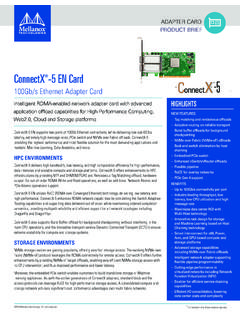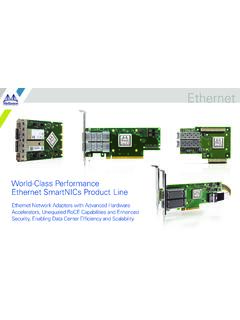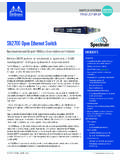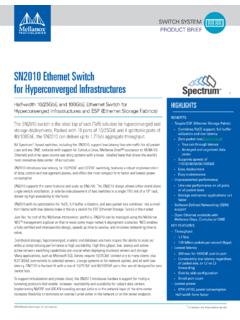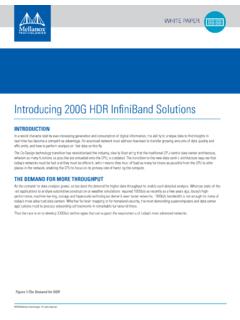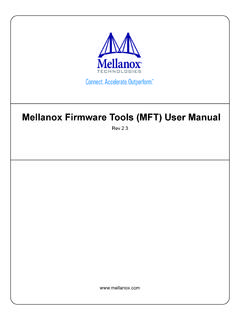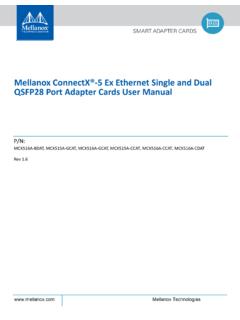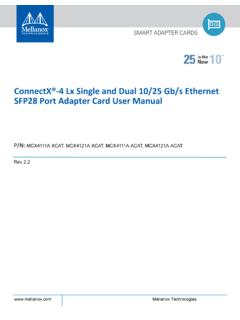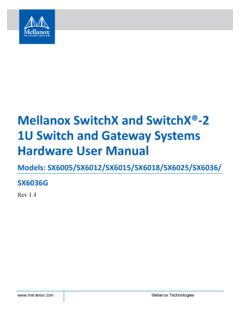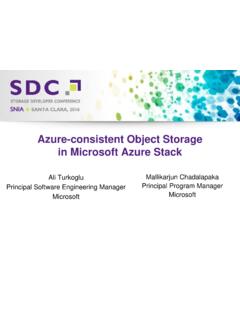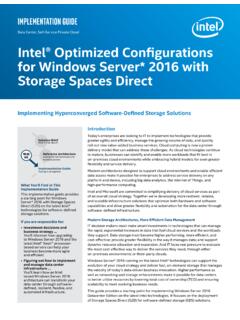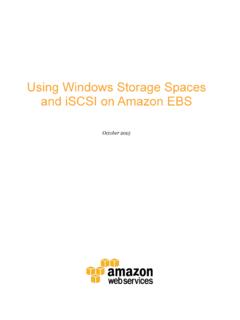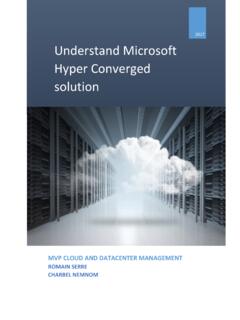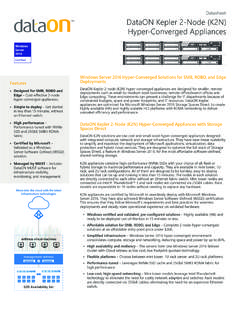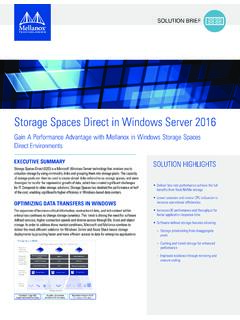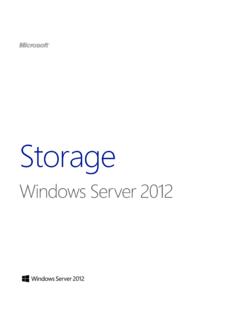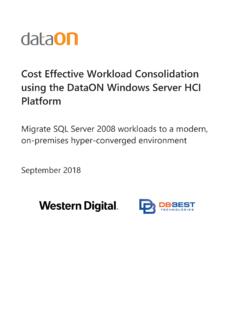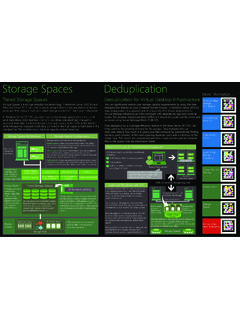Transcription of AMD EPYC Microsoft Storage Spaces Direct (SD2)
1 VM density on a Microsoft Storage Spaces Direct solution powered by the AMD EPYC 7601 processor | Commissioned by AMD November 2017VM density on a Microsoft Storage Spaces Direct solution powered by the AMD EPYC 7601 processorBusinesses seeking solutions for software-defined Storage will soon have even more options to choose from in terms of server configuration. Earlier this year, AMD unveiled a new line of processors: the AMD EPYC series. Built on an architecture called Zen, the EPYC series of processors aims to provide datacenters with a high core the Principled Technologies datacenter, we deployed Microsoft Storage Spaces Direct to a three-node cluster powered by the AMD EPYC 7601 processor. We then measured the cluster s performance with VMFleet, a tool from Microsoft that generates Storage -intensive loads for Microsoft Windows Server cluster, which used a Mellanox end-to-end networking solution, hosted 192 virtual machines, each matching the 1,100 IOPS limit of the P15 Premium Managed Disk offering from Microsoft Azure.
2 The cluster managed this while using (on average) percent of the host processor, and while also keeping average read latency at milliseconds. Low CPU utilization leaves headroom for other tasks, and the sub-millisecond read latency means applications can quickly receive data from Storage . A business that takes advantage of the solution s density could also save on the cost of power, cooling, and management by reducing its datacenter proof-of-concept study provides detailed information on our setup and our testing methods. We report benchmarking data and also provide detailed information on the Zen 192 VMs matching the IOPS requirement for the Microsoft Azure P15 Premium Managed Disk offering23 .22% average host CPU utilization leaves headroom for other workloads average read latency ensures fast data deliveryA Principled Technologies proof-of-concept study: Hands-on work.
3 Real-world density on a Microsoft Storage Spaces Direct solution powered by the AMD EPYC 7601 processor | Commissioned by AMD November 2017 | 2 How software-defined Storage addresses challenges in traditional, array-based architectureTraditionally, enterprise and datacenter server environment architectures have kept the functions of compute and Storage separate. Persistent Storage and its associated requirements (such as resiliency, high performance, deduplication, and tiering) existed separately from the compute layer. However, the traditional architecture has brought challenges. Storage teams and infrastructure teams often exist in isolated silos, and support contracts often vary by Storage or compute vendor. Traditional Storage often requires multiple administrative consoles, complicating the management process.
4 It can also have barriers of entry in terms of cost, and often require professional services for operational needs such as scaling Storage (SDS) solutions may address some of these challenges. In an SDS solution, Storage devices are locally attached to servers and presented to software1. The software then handles features such as resiliency levels, deduplication options, tiering, and write caching. Administrators may present Storage pools to users and applications as this proof-of-concept study, we present the configuration of an SDS solution that uses Microsoft Storage Spaces Direct with servers powered by the AMD EPYC processor. We also demonstrate the solution s I/O performance using DISKSPD via VMFleet. Our configurationHardware We installed Microsoft Storage Spaces Direct onto a cluster comprised of three dual-socket, 2U whitebox servers powered by the AMD EPYC 7601 processors.
5 We used a top-of-rack Mellanox SN2700 Open Ethernet 100 GbE networking switch as well as Mellanox ConnectX -4 Lx 25 GbE dual-port adapters. We used 100 GbE-to-4x LinkX 25 GbE breakout cables to connect the adapters to the server contained eight Samsung PM863 SATA SSDs (configured as capacity drives) and two Micron 9100 Pro NVMe SSDs (configured as cache drives). Because we used the AMD SOC SATA controller, this configuration did not require an additional Storage controller. We used an additional dual-socket, 2U server to host our Active Directory and Storage Spaces Direct management VMs. We configured each cluster node with 512 GB of DDR4 testing, we installed the latest BIOS, drivers, and firmware for each component. We also set the BIOS power settings to the Mellanox SN2700 Open Ethernet switchThe Mellanox SN2700 100 GbE switch we used is a Spectrum-based, 32-port, ONIE (Open Network Install Environment)-based platform on which you can mount a variety of operating systems.
6 According to Mellanox, the switch lets you use 25, 40, 50 and 100 GbE in large scale without changing power infrastructure more at density on a Microsoft Storage Spaces Direct solution powered by the AMD EPYC 7601 processor | Commissioned by AMD November 2017 | 3 The figure below shows the physical layout of our Storage Spaces Direct system and prerequisitesStorage Spaces Direct requires Windows Server 2016; we chose to use the Datacenter edition for our testing. The VMFleet workload uses VMs with the Core edition of Windows Server 2016. We applied the latest OS updates via Windows Update, and set the OS power management policy to High Performance. Assembling the solutionWe installed Windows Server 2016 Datacenter onto each cluster node and onto our infrastructure VM host. After configuring Active Directory and adding each cluster node to the domain, we added the following server roles to each cluster node: Failover Clustering Hyper-V Data-Center-Bridging RSAT-Clustering-PowerShell Hyper-V-PowerShellWe then configured the network for RoCEv2 RDMA functionality by creating a network Quality of Service (QoS) policy for SMB- Direct .
7 We enabled Flow Control for SMB and disabled it for other traffic. We then applied the QoS policy to our network adapters, set a VLAN, and enabled switchManagement server4x LinkX25 GbE2x LinkX25 GbEActiveDirectoryVMclustermgmtVMMellano x SN2700 Open Ethernet switch64 VMsAMD EPYC processor-powered serverVMVMVMVMVMVMVMVMVMVMVMVMVMVMVMVMVM VMVMVMVMVMVMVM64 VMsAMD EPYC processor-powered serverVMVMVMVMVMVMVMVMVMVMVMVMVMVMVMVMVM VMVMVMVMVMVMVM64 VMsAMD EPYC processor-powered serverVMVMVMVMVMVMVMVMVMVMVMVMVMVMVMVMVM VMVMVMVMVMVMVMM anagement networkAbout Samsung PM863a SSDsSamsung PM863a SATA SSDs leverage the company s 3D (V-NAND) technology to provide Storage capacities of up to TB without increasing the physical footprint of the drive. Learn more at density on a Microsoft Storage Spaces Direct solution powered by the AMD EPYC 7601 processor | Commissioned by AMD November 2017 | 4We then ran the PowerShell cmdlet Test-Cluster, which assesses the hardware and software installed on each node and produces a report with failure, warning, or success notifications for each validation test.
8 When Test-Cluster completes without failures, the Storage Spaces Direct cluster is considered ready for deployment. We made sure that the Test-Cluster cmdlet reported only success on all validation tests before deploying the create the cluster, we ran the PowerShell cmdlet New-Cluster with the NoStorage parameter. The NoStorage parameter allowed us to choose the Storage devices we wanted after cluster creation. Once the cluster was created, we used the disk cleaning PowerShell script provided by Microsoft ( ) to prepare our drives for cluster use. Once the drives were cleaned and showed True for the property CanPool, we added them to our cluster with the Enable-ClusterStorageSpacesDirect take full advantage of the high-performance NVMe PCIe drives, we set the Storage Spaces Direct cache to handle reads and created volumes with the New-Volume cmdlet, and sized each volume at terabytes with three-way mirroring resiliency.
9 We also created a 10GB volume to store VMFleet PowerShell scripts and chose the size and count of the VMs to fully provision CPU threads on the host. We used VMFleet to clone 192 VMs from the base Windows Server 2016 Core Edition virtual hard disk. The VMFleet VMs contained two virtual CPUs, 1792MB of DDR4 memory, and a 32GB fixed-size virtual hard disk. Before running the workload, we set a Storage QoS policy using Windows PowerShell and VMFleet tools. We set the IOPS limit of each VM to 1,100 IOPS to match the IOPS limit on the Azure P15 Premium Managed Disk offering. The workloads we used to test our setupBasic overviewDISKSPD is a Microsoft tool for measuring Storage performance, available via GitHub. Microsoft includes DISKSPD in a set of scripts called VMFleet, which enables hyperconverged guests in Windows Server 2016 Storage Spaces Direct to run the tool.
10 VMFleet also helps with creating and monitoring VMs, as well as aggregating the resulting data. Using VMFleet allows one to better understand how a Storage Spaces Direct cluster will perform under varying I/O load ,3 Running the workloadWe created 64 VMs per node and targeted the Azure P15 Premium Managed Disk service level by setting a Storage QoS policy equal to the Azure P15 limit of 1,100 running each test, we ensured each Cluster Shared Volume (CSV) was mounted to the correct server node. For example, the first cluster node owned VMs 1 through 64 as well as the volume (Volume1) that housed them. We also made sure that all CSVs displayed a Healthy status in Failover Cluster Manager, and that no Storage jobs were running. This was to ensure that the disks were not undergoing background repair tasks during our test density on a Microsoft Storage Spaces Direct solution powered by the AMD EPYC 7601 processor | Commissioned by AMD November 2017 | 5We chose a workload typical of a web hosting environment that serves large numbers of page views from a static database.
